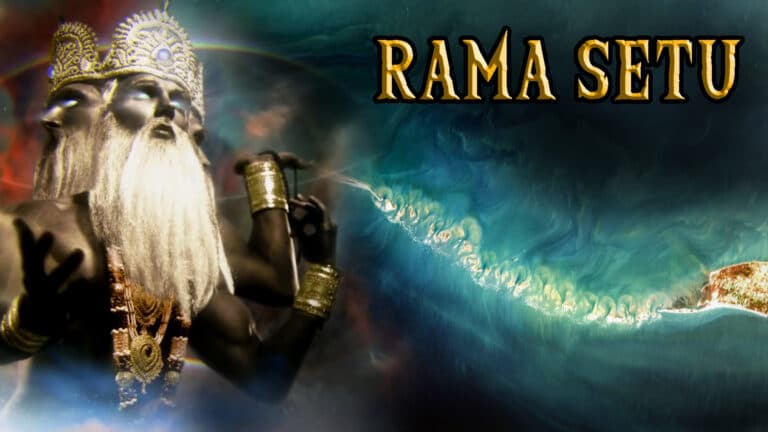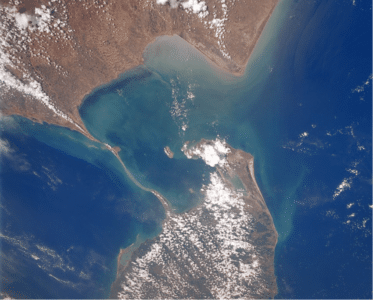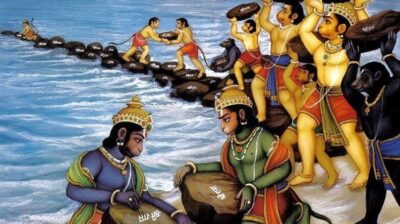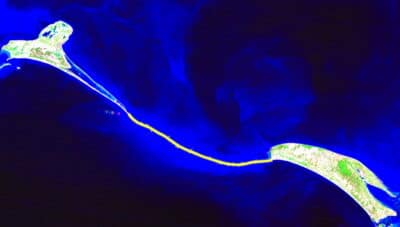Off the southeastern coast of India, a 30-mile-long shoal exists just under the ocean, a bridge of sand and other debris stretching all the way to the northwestern coast of Sri Lanka, separating the Gulf of Mannar on one side from the Palk Strait on the other. Located less than 4 feet under the water in most places, this shoal has seriously hindered regional trade for centuries, allowing only small boats and dinghies to navigate the area, while forcing large, ocean-going vessels to travel all the way around Sri Lanka, adding an extra 250 miles to any journey.
In 2005, the government of India announced approval for the monumental Sethusamudram Canal Project, which would dredge the ocean floor in order to create a channel through the area for large ships, significantly boosting the efficiency of regional trade. There was only one problem. The debris under the water wasn’t just any shoal, but a place of preeminent spiritual importance to millions, even billions of people.
For Hindus, it is an ancient causeway constructed by the legendary figure Rama to facilitate his army crossing from India to Sri Lanka to rescue his abducted wife, Sita, from the evil King Ravana. Hindus do not view it as a natural shoal formation, but as an ancient man-made bridge known as Rama Setu, meaning the Bridge of Rama. Interestingly, historical record shows that what today is a shoal was, in fact, above water, a traversable bridge that could be crossed on foot until 1480, when it was breached by a storm and slowly overcome.
Moreover, Islamic tradition tells of Adam – the first man who was also a 100 feet tall giant, who fell on Earth in Sri Lanka after his expulsion from heaven. In order to escape from the island and find Eve, he constructed a massive bridge to cross into mainland Asia. Like Hindus, Muslims also believe this is not just another ocean formation but an ancient structure they call Adam’s Bridge. In fact, one of the highest peaks in Sri Lanka is also named after Adam, the Adam’s Peak, which according to the story, is the place where Adam first landed on Earth. On an altar on the top of the peak, we can find a giant footprint which is believed to be the footprint of Adam, drawing pilgrims from all over the world to visit the holy place.
Because of this deep religious significance, the Sethusamudram Canal Project immediately became the subject of great controversy when it was announced, causing an uproar amongst many politicians, religious groups, and ordinary people.
And yet, if you venture to look more closely at the bridge and its mysterious creation, it becomes clear that the controversy goes deeper than religion, that it may in fact, challenge humanity’s established history and begin to reveal mythical secrets which have long been lost.
Rama Setu in the Ramayana
The Ramayana is one of the two most important epics, along with the Mahabharata, in all of Hinduism. Composed over the course of nearly a millennium, it is made up of about 24,000 verses, making it one of the largest ancient epics in world literature.
Within these verses is a narration of the life of Rama, the legendary prince of the ancient kingdom of Kosala, which is said to have existed millions of years in the past in the Treta Yuga – a mythological period of time that began 2,165,000 years ago and lasted until 869,000 years ago…
The portion of this story which is most important here can be picked up when Rama enters into exile in the forest with his wife Sita. During this time, Sita is abducted by Ravana, a demon king of Lanka, a rival kingdom. Seeking to recover his wife, Rama raises a mighty army of creatures called Vanara, human-like monkeys who live in the forest, and sets off in pursuit.
After some time, Rama and his army reach the coast of India, from which they can see across the ocean to the distant shores of Sri Lanka, where Sita has been taken. Yet, with the turbulent ocean blocking the path of Rama’s army and no way to get across, it seems their pursuit will end in failure.
However, then Rama begins the construction of a massive bridge with the help of his army of monkey people, and a Vanara architect named Nala.
With the ingenuity of Nala, the bridge is built from India to Sri Lanka in only five days, allowing Rama’s mighty army to cross the ocean. As the Ramayana describes,
“That colossal bridge, which was broad, well-constructed, glorious, well-postured, and held together firmly, looked beautiful like a separating straight line in the ocean. The highly terrific sound of the ocean was covered up by the great sounds of the terrific monkeys who were crossing the sea.”
Once in Sri Lanka, Rama defeats Ravana in battle, killing him and rescuing his wife, before returning home as the incredible story concludes.
What is most important about this story is that for many Hindus, it is not merely a myth, but a record of history, not allegory or religious teaching, but fact. This forms the core of the debate over Rama Setu – is it a construction built by the patriarchs of Hinduism, millions of years in the past and recorded in the Ramayana, or is it simply a natural formation explained by those who didn’t know through a myth taken as truth?
Dr. Badrinarayanan's Research on Rama Setu
When the government of India began putting together what would become the Sethusamudram Canal Project in the early-2000s, they knew it would be controversial. For this reason, one year before the project was announced, they enlisted the services of Dr. Badrinarayanan, the director of the Geological Survey of India, to carry out a study of Rama Setu, presumably in an effort to collect evidence that the shoal was a natural formation which could then be used against opponents and critics.
However, when Badrinarayanan and his team began to drill boreholes along the bridge, what they found shocked them. Six meters below the sandy surface of the bridge, they found a layer of coral and boulders sitting on top of another layer of sand some 13-16 feet deeper, which in turn sat on hard rock formations below that. The reason this was so shocking was described by Badrinarayanan:
“Corals are found only on rocks and such hard surfaces. Here, below the corals and boulders, we are getting loose sand, which means it is not natural.”
In other words, the coral could not have grown there on its own; it must have been deposited there by somebody.
With this discovery, Badrinarayanan knew he needed to explore the bridge further, so he sent divers down to examine the boulders, which mixed with the coral below the surface. When he did, things got even more astonishing. In Badrinarayanan’s words,
“On top of the loose sand, which was formed when the sea level was low, our divers found boulders. Boulders normally occur on land, and they are a typical riverine character. They are not a local marine formation. We feel somebody dumped the boulders to use them as a causeway. The boulders on top of the loose sand are transported to that place. As they are found above loose sand, it is quite obvious that they were brought and dumped there by somebody. All these things lead us to believe that 2 to 2.5 meters of packed rubble or material appear to be a modern-day causeway. For 30 km, nobody dumps materials like that. Obviously, it was dumped to use it to cross the sea.”
Far from proving that Rama Setu was a natural formation, Badrinarayanan had actually come to the opposite conclusion. The evidence, in his words, “clearly establishes the fact that Rama Setu is very much man-made.”
While proving that Rama Setu is man-made does not prove it was built by Rama, as the Ramayana describes, it does raise some interesting questions. If it was, in fact, man-made, as Badrinarayanan was asserting, then who could have built such an astonishing structure, a bridge across the ocean, that far in the past?
How Was Rama Setu Built?
To begin to answer this question, we might return to the Ramayana, which in fact, contains a detailed description of Rama Setu’s construction.
“Then, being sent by Rama, hundreds and thousands of monkey heroes jumped in joy on all sides towards the great forest. Those army chiefs of monkeys, who resembled mountains, broke the rocks and trees there and dragged them away towards the sea.
The huge-bodied monkeys with mighty strength uprooted elephant-sized rocks and mountains and transported them by mechanical contrivances. Some others drew up strings a hundred Yojanas long in order to keep the rocks in a straight line. Some monkeys were holding poles for measuring the bridge, and some others collected the material. Reeds and logs resembling clouds and mountains, brought by hundreds of monkeys, led by the command of Rama, fastened some parts of the bridge.
That Nala, the strong and illustrious son of Vishwakarma and an excellent monkey built the bridge across the sea as truly as his father would have built it. That beautiful and lovely bridge constructed by Nala across the ocean, the abode of alligators, shone brightly like a milky way of stars in the sky.”
It is an astonishing description of an incredible project. But within the description, one line, in particular, stands out – where the monkeys “uprooted elephant-sized rocks and mountains and transported them by mechanical contrivances.”
What type of “mechanical contrivances” would have allowed Rama Setu’s builders to transport and place “elephant-sized rocks and mountains” for many miles across the open ocean? What type of technology did they have that allowed them to complete the building of a bridge which even today would be exceeding difficult?
One thing is for sure. Whatever the ‘mechanical contrivances’ used to move and stack huge boulders, this is not the only time seemingly impossible advanced technology appears in the Ramayana.
Vimanas - Flying Vehicles of the Gods
When, within the Ramayana, the demon king Ravana abducts Rama’s wife Sita, he does not simply grab her and walk away. Rather, he abducts her using a flying machine he has stolen from the gods known as the ‘Pushpaka Vimana.’ When Rama eventually defeats Rama, it is this same flying machine in which he flies home with his wife.
But what is this Pushpaka Vimana? In the text, it is described as a “chariot resembling a bright cloud in the sky” that “rose up into the higher atmosphere.” If they were able to build a bridge across the ocean, is it possible that the people of Rama’s time also had access to flying machines that could reach the ‘higher atmosphere’?
Those familiar with Hindu texts will know that the Ramayana is far from the only place these flying machines appear. They are broadly known as Vimana, meaning “measuring out” or “traversing,” and they appear many times across Hindu epics. Perhaps the most well-known description appears in the Samarangana Sutradhara, where it is written,
“Strong and durable must the body of the Vimana be made, like a great flying bird of light material. Inside one must put the mercury engine with its iron heating apparatus underneath. By means of the power latent in the mercury, which sets the driving whirlwind in motion, a man sitting inside may travel a great distance in the sky. The movements of the Vimana are such that it can vertically ascend, vertically descend, and move slanting forwards and backwards. With the help of the machines human beings can fly in the air and heavenly beings can come down to earth.”
Again, remember that many Hindus view the information contained within the epics as historical facts. Could Vimanas, these astonishing flying machines, have actually existed? And if so, how could the ancients have built them? What type of technology could they have had that we apparently do not have today?
In modern times, the beginning of an answer has started to appear …
Advanced Ancient Technology
In 2003, a Sanskrit scholar from China named Ye Shaoyong was searching through old, forgotten manuscripts at a Tibetan monastery when he came across something stunning. There, amidst mountainous piles of old documents, he found a stack of yellowed palm leaves covered in an ancient Sanskrit writing older than he had ever seen. Immediately recognizing the importance of his discovery, Ye removed the manuscripts and began working with a team on their translation.
Over the course of more than a decade, the words contained within the manuscripts were slowly revealed. Amazingly, not only did they divulge new insights into the philosophy and history of India, but, according to one of the translators, they even gave directions for building an operational Vimana.
The secret of the incredible capabilities of the Vimana described in the Hindu epics was, according to this translator, an “anti-gravitational” technology utilizing “a centrifugal force strong enough to counteract all gravitational pull.”
Could it really be possible that the ancients had discovered the secrets of anti-gravity? Those who have watched our channel before will know that it is not as impossible as it may seem. In fact, you can watch our comprehensive video on Viktor Grebennikov and the secrets of anti-gravity hidden in nature to find out just what the ancients may have known.
In either case, this revelation on how Vimanas were built, and how they worked, was so groundbreaking, that many scholars began to assert the Vimanas contained within the Hindu epics must be real. As one such scholar put it after conducting a comprehensive study of Hindu flying machines, the descriptions of Vimanas contained within the texts were “too detailed and technical in nature to be labeled as myth.”
If this is true, then it is possible that the secrets of this advanced ancient technology remain hidden right under our noses. After Ye’s discovery in 2003, scholars quickly realized that many thousands of previously undiscovered Sanskrit manuscripts were lying forgotten in Tibetan temples. Already, some 500 bundles of palm leaves with many thousands of lines of ancient text have been recovered and await translation. As these words are translated, might they further reveal the secrets of an advanced technology possessed by the ancients?
Super-Weapons of the Gods
Throughout ancient Hindu texts, there are numerous accounts of magical superweapons wielded and utilized to terrible effect. Perhaps the most infamous description of such a weapon comes from the Mahabharata.
“Gurkha, flying in his swift and powerful Vimana, hurled against the three cities of the Vrishnis and Andhakas a single projectile charged with all the power of the universe. An incandescent column of smoke and fire, as brilliant as ten thousand suns, rose in its entire splendor. It was the unknown weapon, the iron thunderbolt, a gigantic messenger of death which reduced to ashes the entire race of Vrishnis and Andhakas.
There was neither a counter-attack nor a defense that could stop it. It was as if the elements had been unleashed. The sun spun round. Scorched by the incandescent heat of the weapon, the world reeled in fever. Elephants were set on fire by the heat and ran to and fro in a frenzy to seek protection from the terrible violence. The water boiled, the animals died, the enemy was mown down and the raging of the blaze made the trees collapse in rows as in a forest fire. The elephants made a fearful trumpeting and sank dead to the ground over a vast area. Horses and war chariots were burnt up, and the scene looked like the aftermath of a conflagration. Thousands of chariots were destroyed, then deep silence descended on the sea. The winds, began to blow and the earth grew bright. It was a terrible sight to see. The corpses of the fallen were mutilated by the terrible heat so that they no longer looked like human beings.”
Remember, many Hindus believe that stories like these represent historical records. If the ancients could have possessed the secrets of anti-gravity, which allowed them to create flying machines, could they also have possessed superweapons “charged with all the power of the universe?” Interestingly, evidence supporting this possibility has emerged in modern times. In fact, we have an entire video in which we present all the clues suggesting that ancient nuclear weapons, the so-called weapons of the gods were used in some places on our planet.
But if an ancient civilization did possess this type of technology, the question becomes, who was this advanced ancient civilization, and where did they go?
Some have an answer …
The Lost Continent of Kumari Kandam
In the late-19th century, an English geologist named Philip Sclater published a paper that shook up the scientific world. Titled “The Mammals of Madagascar,” it provided an answer to a question that had long puzzled scientists – why were lemur bones abundant in both India and Madagascar, but missing in the Middle East and Africa, territory through which they presumably would have had to travel to reach one from the other?
The reason, Sclater proposed, was that at one time in the past, India and Madagascar had each been part of a large supercontinent in the Indian Ocean, before this continent sunk beneath the ocean when sea levels rose at the end of the last Ice Age. Sclater named this lost continent “Lemuria” after the lemurs who had started his work.
Interestingly, Hindu texts, including the Ramayana, speak of an ancient continent submerged in the Indian Ocean known as Kumari Kandam, the home of an advanced ancient civilization swallowed by the sea many thousands of years in the past. When Sclater began talking about a lost continent called Lemuria, many believed he was actually referring to Kumari Kandam.
If such a continent did exist in the ancient past, could it have been home to the civilizations spoken about in the Ramayana and other Hindu epics? Could Rama and Ravana have actually been the rulers of advanced civilizations which sunk into the sea? Look at the proposed map of Lemuria. Was Rama Setu not only a bridge between India and Sri Lanka, but a bridge between continents?
Vanaras - Ancient Humans?
Following this line of thinking, we may turn our attention to a different character in the Ramayana, not Rama, but his army who built Rama Setu – the Vanara. While today, Vanara is translated to simply mean ‘monkey,’ some scholars assert that to get to the true meaning of the word, it must be broken down – “vana,” which means ‘forest,’ and “nara,” which means ‘man.’ In other words, not ‘monkey,’ but “forest man.”
Perhaps the Vanara were not actually some mythical monkey creatures, but an early type of human. Consider, at about the same time as the idea of the lost continent of Lemuria was gaining popularity, a German scientist named Ernst Haeckel proposed the theory that the earliest humans may have descended from Asian primates, and even pointed to Lemuria as the place these primates may have come from. Is it possible that the Vanara recorded in the Ramayana were not monkeys, but an early ancestor of human beings, living alongside the advanced races of Rama and Ravana, before spreading across the world after Lemuria sunk and becoming the human race as we know it today? This would be an entirely different origin story for human beings than that presented in our history books today.
If Rama Setu was really built 1.7 million years ago, then that would be the time when Homo Erectus roamed the Earth. The Homo Erectus was the first species to form groups, work with tools, and even wear clothes, mainly animal skins. Could Rama’s army of monkey people actually be the Homo Erectus species?
Lost Advanced Civilization of Kumari Kandam
Moreover, if not humans, then to what race of beings did Rama and Ravana belong? Who were these figures, more advanced than humans at the early stages of development? And if they had flying machines and superweapons, then what else did they know, and could they really have just sunk into the ocean, lost forever?
If we take a step back, we may establish that this is why Rama Setu has become such a controversial topic in modern times. The mystery of its creation is not just a religious matter, but one which opens questions about the entire history of humanity, about advanced ancient civilizations and where human beings came from, and whether history is linear or cyclical.
If you want to find out the answers to these questions, make sure to watch our video on the lost continent of Lemuria.
The thing is, more answers might be coming soon …
The Controversy of Rama Setu
When the government of India announced the plans to dredge Rama Setu, they knew it would be controversial. But they perhaps did not understand quite how controversial the project would become.
Immediately after it was announced, politicians and religious groups organized protests against the project, launching an international campaign called “Save Rama Setu” in the process. By 2007, the supreme court of India had issued an order putting a temporary stop to the project and urging the government to examine alternatives.
Shortly thereafter, the government filed an affidavit with the court stating that there was no evidence Rama Setu had been constructed by people, despite their own scientist, Dr. Badrinarayanan, having found evidence to suggest it was, only a few years prior, while at the same time, conceding that they would follow the court’s directions to temporarily pause the project while a solution was looked for.
This temporary pause has turned into more than a decade-long fight over the future of Rama Setu, with some insisting that it should be named a national monument and given protected legal status, and others maintaining that not only is it a purely natural formation, but that the supreme court does not have the power to block the project.
In 2017, the battle was ratcheted up to another level when the US-based Science Channel released a documentary on Rama Setu entitled “Ancient Land Bridge.” The documentary presented a study conducted by scientists from four major American universities which used satellite imagery to examine the site, alongside previously recovered geological samples.
The results of this study were clear. As one scientist involved in the project put it,
“The sand bar may be natural, but what is sitting on top of it is not. The rocks on top of the sand actually pre-date the sand, so there is more to this story. These results suggest the structure in the satellite image is not natural but built by humans.”
Upon release of the documentary, many insisted that it settled the argument – Rama Setu was man-made, and should be named a protected national monument. At the same time, however, others asked why India was letting Americans tell them about their own country, accusing the study’s scientists of typical Western dramatics.
This was the final straw for the Indian government. They knew that the debate could not be allowed to go on any further, that one way or another, they must solve the mystery once and for all. Consequently, at the start of 2021, the government announced that they would launch the first-ever official exploration and study of Rama Setu in March of that year.
The project would take at least three years to complete, starting with a geological survey and examination of the sub-surface structure, before moving into a more comprehensive laboratory analysis of geological samples taken from deep below the water and within the earth. As The New York Times reported, the purpose would be to “determine once and for all whether the formations clearly visible on the ocean floor are naturally occurring sandbanks or structures made by humans.”
This project is currently ongoing, and many are waiting with bated breath to find out what conclusions may be reached. Is Rama Setu man made? Perhaps more importantly, if it is, what else might scientists find? What other secrets may be revealed?
Curiously, one of the stated purposes of the study is not just to determine if Rama Setu is an artificial structure, but to look for “submerged habitations” that may be around it. In fact, one scientist who is part of the study has already insisted he is “100 percent sure we will find archaeological remains.” What did he mean by this? Are scientists expecting to find the remains of an ancient civilization lost beneath the waves? And might these remains belong to the lost continent of Kumari Kandam?
The fact is, the mystery of Rama Setu is only just beginning. Who knows what secrets will be revealed in the near future, and how they will impact our understanding of human history and the history of earth?




